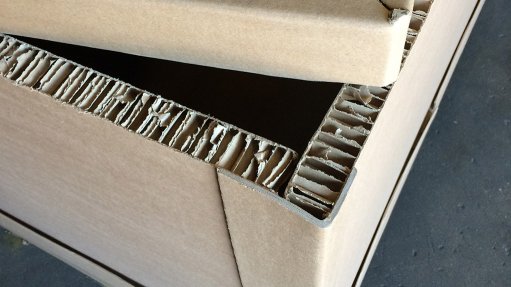
PAPER WEIGHT Honeycomb paperboard has significant compression strength and a 30-mm-thick honeycomb board can withstand a load of more than 8 t
Since July last year, honeycomb paperboard and corrugated pallet manufacturer Kimmo has been supplying KimmoBin honeycomb paperboard crates every month to the South African branch of global materials handling, equipment manufacturing and distribution company Bell Equipment for the safe packaging and transport of mining equipment and supplies.
Kimmo MD Jan Vreken explains that honeycomb paperboard is a rigid, lightweight material, which prevents the sides of the KimmoBin from bulging under pressure. Honeycomb paperboard has significant compression strength and a 30-mm-thick honeycomb board can withstand a load of more than 8 t.
Honeycomb paperboard is produced by laminating layers of thick paper onto a paper honeycomb core, resulting in a structure with significantly high crush resistance and rigidity.
“KimmoBins are modular, which allows for products to be placed on the floor of the bin before the walls are erected and the box is sealed, making packaging goods in KimmoBins easier than wooden crates, as people need to lean inside wooden crates to pack them,” Vreken notes.
He adds that KimmoBins can be flat-packed, allowing for a higher number of honeycomb products to be stored, compared with wooden crates, which are typically fully erected and, therefore, limit the number that can be stacked on top of each other.
KimmoBins are also significantly cheaper than wooden crates and do not require any fumigation or heat treatment, which is required of all wooden products exported across international borders.
As KimmoBins are significantly lighter than wooden crates, transporting goods as airfreight affords further cost savings. Vreken highlights that a 1 m3 KimmoBin weighs about 25 kg, whereas a wooden crate of the same dimensions weighs about 90 kg.
AKimmoBin is also easier to move around a warehouse, as two people can carry it, whereas wooden crates need to be moved with a pallet jack or a forklift, he adds.
Kimmo started supplying its honeycomb paperboard crates in July last year, following a capital investment of about R10-million for new machinery in March.
“We installed a 45-m-long core production line, a 60-m-long honeycomb lamination line, a 40-m-long edge-board line and the ancillary equipment needed to convert honeycomb paperboards into crates to the value of about R10-million. “This enables us to manufacture 500 KimmoBins a day,” Vreken concludes.